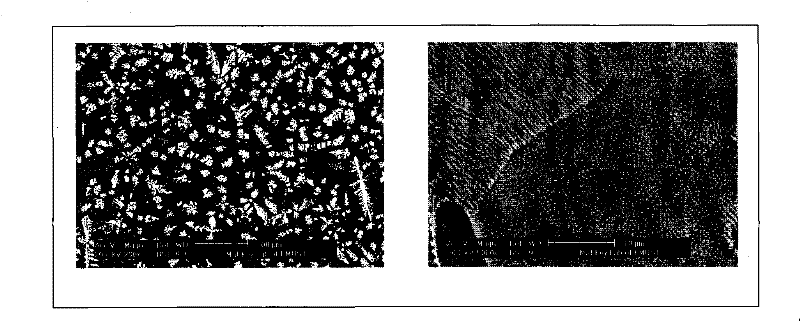High strength low melting-temperature alloy and manufacturing method thereof
A low melting point metal, low melting point technology, applied in the field of alloy material preparation, can solve the problems of low strength, low precision, inconvenient operation, etc., and achieve the effect of improving strength and hardness, improving strength, and reliable application range
- Summary
- Abstract
- Description
- Claims
- Application Information
AI Technical Summary
Problems solved by technology
Method used
Image
Examples
Embodiment 1
[0013] Example 1: Pb-based alloy. Using the in-situ reaction method, add 40% by weight of Ba, Ca, Li, Mg or rare earth elements Dy, La, Y, Gd and other metals and 10% of Al in the induction furnace, heat to 650 ° C, and wait for it After melting, 50% by weight of low melting point metal Pb was added. Stir for 1min to 2min to make Mg and Pb fully react to form intermetallic compounds, stand still for 2min, and cast by bottom casting at a casting temperature of 440°C to prepare a Pb-based alloy material with ultra-high strength and low melting point. And make test samples for testing and analysis of mechanical properties and microstructure. The test results are as follows:
[0014] ①Tensile strength test: Prepare a test sample rod and carry out tensile strength test on a tensile mechanical testing machine. The test results show that the tensile strength of the ultra-high-strength low-melting point Pb-based alloy reaches 228MPa, which is the standard of traditional Babbitt allo...
Embodiment 2
[0017] Embodiment 2: Sn-based alloy. Using the in-situ reaction method, add 30% by weight of Ba, Ca, Li, Mg or rare earth elements Dy, La, Y, Gd and other metals and 8% of Al in the total weight into the induction furnace, heat to 650 ° C, and wait for it After melting, 62% by weight of low-melting metal Sn was added. Stir for 1min to 2min to make Mg and Sn fully react to form intermetallic compounds, stand still for 2min, and cast by bottom casting at a casting temperature of 550°C to prepare an ultra-high-strength, low-melting-point Sn-based alloy material. And make test samples for testing and analysis of mechanical properties and microstructure. The test results are as follows:
[0018] ①Tensile strength test: Prepare a test sample bar for tensile strength test on a tensile mechanical testing machine. The test results show that the tensile strength of the ultra-high-strength low-melting-point Sn-based alloy reaches 180MPa, which is the standard of traditional Babbitt all...
Embodiment 3
[0020] Embodiment 3: Bi-based alloy. Using the in-situ reaction method, add 30% by weight of Ba, Ca, Li, Mg or rare earth elements Dy, La, Y, Gd and other metals and 5% of Al in the total weight into the induction furnace, heat to 650 ° C, and wait for the After melting, 65% by weight of low-melting metal Bi was added. Stir for 1min to 2min to make Mg and Bi fully react to form intermetallic compounds, stand for 2min, and cast by bottom casting at a casting temperature of 600°C to prepare an ultra-high-strength, low-melting-point Bi-based alloy material. And make test samples for testing and analysis of mechanical properties and microstructure. The test results are as follows:
[0021] ①Tensile strength test: The test sample bar was prepared and tested for tensile strength on a tensile mechanical testing machine. The test results showed that the tensile strength of the ultra-high-strength low-melting point Bi-based alloy reached 200MPa.
[0022] ②Brinell hardness test: The ...
PUM
| Property | Measurement | Unit |
|---|---|---|
| melting point | aaaaa | aaaaa |
| hardness | aaaaa | aaaaa |
| strength | aaaaa | aaaaa |
Abstract
Description
Claims
Application Information
 Login to View More
Login to View More - R&D
- Intellectual Property
- Life Sciences
- Materials
- Tech Scout
- Unparalleled Data Quality
- Higher Quality Content
- 60% Fewer Hallucinations
Browse by: Latest US Patents, China's latest patents, Technical Efficacy Thesaurus, Application Domain, Technology Topic, Popular Technical Reports.
© 2025 PatSnap. All rights reserved.Legal|Privacy policy|Modern Slavery Act Transparency Statement|Sitemap|About US| Contact US: help@patsnap.com

